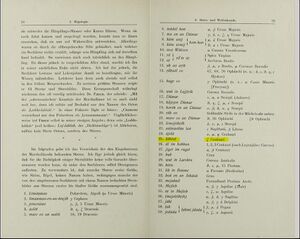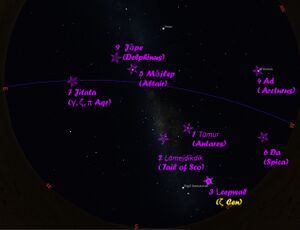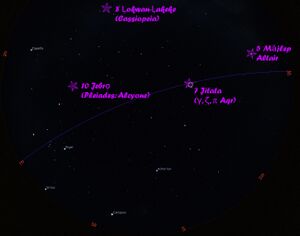Leepwal: Difference between revisions
Cliveruggles (talk | contribs) |
IanRidpath (talk | contribs) |
||
| (30 intermediate revisions by 4 users not shown) | |||
| Line 1: | Line 1: | ||
[[File:Erdland1914 Leepwal.jpg|alt=screenshot(s) of text|thumb|Leepwal as German transliteration "Läböol" in Erdland's book (1914).]] |
|||
Original spelling Ļeepwal. Pronounced leyepwal, the first "l" being pronounced with the back of the tongue raised (velarized) and the root of the tongue retracted (pharyngealized) so as to elongate the oral cavity, thereby giving the consonant a "heavier" or "darker" sound. Ļeepwal is the name for ζ Cen in Marshallese. |
|||
==Etymology and History== |
==Etymology and History== |
||
This star name originates from the Marshall Islands. Ļeepwal is the third child of Lōktañūr (Capella), the mother of all stars. |
This star name originates from the Marshall Islands. Ļeepwal is the third child of Lōktañūr (Capella), the mother of all stars. |
||
The name Ļeepwal (in modern Marshallese) was originally recorded as ''"'''Läbôol'''"'' by the Catholic missionary August Erdland, who lived in the Jaluit Atoll from 1904 to 1914 ([https://archive.org/details/diemarshallinsul00erdl/page/78/mode/2up Erdland 1914: 79 #25]). |
|||
The mother of all great stars, her ten offspring being ''Tūṃur'' (Antares (α Sco), or Paikauhale, Antares, and Alniyat (τ, α, and σ Sco)), the eldest; ''Ḷōmejdikdik'' (Shaula (λ Sco), Lesath (υ Sco), ι Sco, and κ Sco), the second; ''Ḷeepwal'' (ζ Cen), the third; ''Ad'' (Arcturus (α Boo)), the fourth; ''Mājlep'' (Altair, Alshain, and Tarazed (α, β, and γ Aql)), the fifth; ''Da'' (Spica (α Vir), the sixth; ''Jitata'' (Sadachbia (γ Aqr), ζ and π Aqr), the seventh; ''Ḷokwan-Ḷakeke'' (Cassiopeia), the eighth; ''Jāpe'' (Sualocin (α Del), Rotanev (β Del) and γ Del), the ninth; and ''Jebrọ'' (or ''Jeḷeilōñ''), Alcyone (η Tau) in the Pleiades, the youngest [Abo ''et al.'' 2019, various entries] |
|||
==Mythology== |
==Mythology== |
||
According to commonly known Marshallese mythology, ''Lōktañūr (''Capella), the mother of all great stars, has ten offspring (Abo ''et al''. 2019). ''Tūṃur'', a son, is the eldest: this name and variants have also been recorded around Micronesia and generally apply either to Antares or to the asterism Paikauhale, Antares, and Alniyat (τ, α, and σ Sco) (Johnson ''et al''.). ''Ḷōmejdikdik'', the second child, is the asterism formed by Shaula (λ Sco), Lesath (υ Sco), ι Sco, and κ Sco in the tail of Scorpius. ''Ḷeepwal'' (ζ Cen) is the third child; ''Ad'' (Arcturus), the fourth; and ''Mājlep'', "big eye" (Altair, Alshain, and Tarazed — α, β, and γ Aql), the fifth (Abo ''et al''. 2019). The name Mailap and variants are widespread in Micronesia and are mostly identified with Altair (Johnson ''et al''.). Lōktañūr’s sixth child is ''Da'' (Spica), the seventh is ''Jitata'' (γ, ζ and π Aqr), the eighth is ''Ḷokwan-Ḷakeke'' (Cassiopeia), and the ninth is ''Jāpe'', "bowl" (α, β and γ Del). |
|||
The legend of Lōktañūr and her sons (of whom there are more than ten in some versions) is well known in the Marshall Islands. According this this story, Ḷeepwal, or Lobol, and his brothers had a canoe race to determine who would be the next chief. The race was won by Jebro, the youngest.<ref>https://pfwpproject.wordpress.com/wp-content/uploads/2018/07/marshall-islands-the-111.pdf, 15-17</ref> Jebro is identified as Alcyone (η Tau) in the Pleiades and as a male—the king of the stars. He was also known by various other names: Mājdik when small, Buonṃar when he began the contest with his brothers, Jeḷeilōñ when he became king, Dāpeej as an old man, and also sometimes as Jetakdik (Abo ''et al''. 2019). |
|||
[[File:Ten-sons Loctanur Stellarium.jpg|alt=Stellarium map|thumb|Sky over Indonesia, the visible stars of the ten sons marked (not all visible simultaneously), Stellarium map - markings: Susanne M Hoffmann (2024) according to Erdland's identifications. ]] |
|||
[[File:Ten-sons Loctanur Stellarium2.jpg|alt=Stellarium map|thumb|Sky over Indonesia, the visible stars of the ten sons marked (not all visible simultaneously), Stellarium map - markings: Susanne M Hoffmann (2024) according to Erdland's identifications (1914). ]] |
|||
=== Catasterism === |
|||
Many people will look for a chain or other clear (geometrical) pattern of ten stars/asterisms to fit the "Ten Sons of Loktanur" in the sky. However, the original constellation does not seem to provide such a pattern. The stars are scattered all over the place. |
|||
Loktanur's ten sons in order are |
|||
* (1) ''Tūṃur'', Antares or (τ, α, and σ Sco), |
|||
* (2) ''Ḷōmejdikdik'', tail of Scorpius, |
|||
* (3) ''Ḷeepwal'' (ζ Cen), |
|||
* (4) ''Ad'' (Arcturus), |
|||
* (5) ''Mājlep'', Altair or (α, β, and γ Aql), |
|||
* (6) ''Da'' (Spica), |
|||
* (7) ''Jitata'' (γ, ζ and π Aqr), |
|||
* (8) ''Ḷokwan-Ḷakeke'' (Cassiopeia), |
|||
* (9) ''Jāpe'', "bowl" (α, β and γ Del), and |
|||
* (10) ''Jebrọ'' (Alcyone). |
|||
==IAU Working Group Star Names== |
==IAU Working Group Star Names== |
||
Since 2021, it was suggested to consider the name "Leepwal" (originally spelled "Ļeepwal" in Marshallese) for [https://simbad.u-strasbg.fr/simbad/sim-id?Ident=zet+Cen&NbIdent=1&Radius=2&Radius.unit=arcmin&submit=submit+id ζ Cen (SIMBAD)] in the IAU-Catalog of Star Names. The star is a 2.55 mag spectroscopic binary and currently lacks a name in SIMBAD. "'''Leepwal'''" appeared extremely unique - as of 2024, it remarakably did not appear in any Google-accessible websites or books. |
|||
The name was discussed and approved by the IAU WGSN 2022-2024. applied to the star ... in the IAU-CSN. |
|||
== |
=== Other names === |
||
Other historical names were also considered for ζ Cen: |
|||
* in Allen (1899): "ζ probably being Al Tizini's '''Al Nā᾽ir al Baṭn al Kentaurus''', ''the Bright One in the Centaur's Belly''") and |
|||
| ⚫ | |||
* [https://archive.org/details/untersuchungenb01idelgoog/page/n273/mode/2up Ideler (1809, footnote 3, p.275]; ). Ideler mentions Al Tizini's "'''''Nair baden Kentaurus'''''" - bright one on the Centaur's belly''.'' |
|||
| ⚫ | |||
* '''''[[Alnair]]''''' or '''''Al Na'ir''''': "the bright one" - Kunitzsch (1983), Kunitzsch & Smart (2006) - however the name is duplicative with "Alnair", which was already adopted by IAU WGSN for alf Gru (as it was much more commonly used for in recent centuries). |
|||
* '''''Baten Kentaurus''''' (Rhoads 1971) is a useful shortened version, although similar to Rigil Kentaurus and Baten Kaitos, which have already been adopted by IAU WGSN for Alpha Centauri A and Zeta Ceti (might be confusing having "Baten Kaitos" for zet Cet and "Baten Kentaurus" for zet Cen!). |
|||
* Schaaf (2008) has "'''Al Nair al Kentaurus'''", missing the Batn/Baten/etc. |
|||
In 2024, the IAU WGSN adopted the name Leepwal (Ļeepwal) for ζ Cen and added it to the IAU Catalog of Star Names. |
|||
== Reference == |
|||
==Weblinks== |
|||
* Website of the IAU WGSN: https://exopla.net/ |
|||
== References == |
|||
| ⚫ | |||
*Erdland, Peter August, ''Die Marshall-Insulaner: Leben und Sitte, Sinn und Religion eines Südsee-Volkes'' (Münster i.W.: Aschendorffsche Verlagsbuchhandlung, 1914 [= ''Anthropos'', Band II, Heft 1]) [[https://archive.org/details/diemarshallinsul00erdl/ Internet Archive link]]. |
|||
| ⚫ | |||
[[Category:Single star-asterism]] |
[[Category:Single star-asterism]] |
||
[[Category:Asterism]] |
|||
[[Category:Star Name]] |
|||
[[Category:Oceania]] |
[[Category:Oceania]] |
||
[[Category:Marshallese]] |
|||
[[Category:IAU-Star Name]] |
|||
[[Category:Cen]] |
|||
Latest revision as of 20:08, 18 June 2025
Original spelling Ļeepwal. Pronounced leyepwal, the first "l" being pronounced with the back of the tongue raised (velarized) and the root of the tongue retracted (pharyngealized) so as to elongate the oral cavity, thereby giving the consonant a "heavier" or "darker" sound. Ļeepwal is the name for ζ Cen in Marshallese.
Etymology and History
This star name originates from the Marshall Islands. Ļeepwal is the third child of Lōktañūr (Capella), the mother of all stars.
The name Ļeepwal (in modern Marshallese) was originally recorded as "Läbôol" by the Catholic missionary August Erdland, who lived in the Jaluit Atoll from 1904 to 1914 (Erdland 1914: 79 #25).
Mythology
According to commonly known Marshallese mythology, Lōktañūr (Capella), the mother of all great stars, has ten offspring (Abo et al. 2019). Tūṃur, a son, is the eldest: this name and variants have also been recorded around Micronesia and generally apply either to Antares or to the asterism Paikauhale, Antares, and Alniyat (τ, α, and σ Sco) (Johnson et al.). Ḷōmejdikdik, the second child, is the asterism formed by Shaula (λ Sco), Lesath (υ Sco), ι Sco, and κ Sco in the tail of Scorpius. Ḷeepwal (ζ Cen) is the third child; Ad (Arcturus), the fourth; and Mājlep, "big eye" (Altair, Alshain, and Tarazed — α, β, and γ Aql), the fifth (Abo et al. 2019). The name Mailap and variants are widespread in Micronesia and are mostly identified with Altair (Johnson et al.). Lōktañūr’s sixth child is Da (Spica), the seventh is Jitata (γ, ζ and π Aqr), the eighth is Ḷokwan-Ḷakeke (Cassiopeia), and the ninth is Jāpe, "bowl" (α, β and γ Del).
The legend of Lōktañūr and her sons (of whom there are more than ten in some versions) is well known in the Marshall Islands. According this this story, Ḷeepwal, or Lobol, and his brothers had a canoe race to determine who would be the next chief. The race was won by Jebro, the youngest.[1] Jebro is identified as Alcyone (η Tau) in the Pleiades and as a male—the king of the stars. He was also known by various other names: Mājdik when small, Buonṃar when he began the contest with his brothers, Jeḷeilōñ when he became king, Dāpeej as an old man, and also sometimes as Jetakdik (Abo et al. 2019).
Catasterism
Many people will look for a chain or other clear (geometrical) pattern of ten stars/asterisms to fit the "Ten Sons of Loktanur" in the sky. However, the original constellation does not seem to provide such a pattern. The stars are scattered all over the place.
Loktanur's ten sons in order are
- (1) Tūṃur, Antares or (τ, α, and σ Sco),
- (2) Ḷōmejdikdik, tail of Scorpius,
- (3) Ḷeepwal (ζ Cen),
- (4) Ad (Arcturus),
- (5) Mājlep, Altair or (α, β, and γ Aql),
- (6) Da (Spica),
- (7) Jitata (γ, ζ and π Aqr),
- (8) Ḷokwan-Ḷakeke (Cassiopeia),
- (9) Jāpe, "bowl" (α, β and γ Del), and
- (10) Jebrọ (Alcyone).
IAU Working Group Star Names
Since 2021, it was suggested to consider the name "Leepwal" (originally spelled "Ļeepwal" in Marshallese) for ζ Cen (SIMBAD) in the IAU-Catalog of Star Names. The star is a 2.55 mag spectroscopic binary and currently lacks a name in SIMBAD. "Leepwal" appeared extremely unique - as of 2024, it remarakably did not appear in any Google-accessible websites or books.
Other names
Other historical names were also considered for ζ Cen:
- in Allen (1899): "ζ probably being Al Tizini's Al Nā᾽ir al Baṭn al Kentaurus, the Bright One in the Centaur's Belly") and
- Ideler (1809, footnote 3, p.275; ). Ideler mentions Al Tizini's "Nair baden Kentaurus" - bright one on the Centaur's belly.
- Alnair (النائر) or Al Na'ir: "the bright one" - Kunitzsch (1983), Kunitzsch & Smart (2006) - however the name is duplicative with "Alnair", which was already adopted by IAU WGSN for alf Gru (as it was much more commonly used for in recent centuries).
- Baten Kentaurus (Rhoads 1971) is a useful shortened version, although similar to Rigil Kentaurus and Baten Kaitos, which have already been adopted by IAU WGSN for Alpha Centauri A and Zeta Ceti (might be confusing having "Baten Kaitos" for zet Cet and "Baten Kentaurus" for zet Cen!).
- Schaaf (2008) has "Al Nair al Kentaurus", missing the Batn/Baten/etc.
In 2024, the IAU WGSN adopted the name Leepwal (Ļeepwal) for ζ Cen and added it to the IAU Catalog of Star Names.
Weblinks
- Website of the IAU WGSN: https://exopla.net/
References
- Abo, Takaji, Byron W. Bender, Alfred Capelle, and Tony DeBrum (2019). Marshallese-English Online Dictionary. Honolulu: University of Hawai‘i Press. [2]
- Erdland, Peter August, Die Marshall-Insulaner: Leben und Sitte, Sinn und Religion eines Südsee-Volkes (Münster i.W.: Aschendorffsche Verlagsbuchhandlung, 1914 [= Anthropos, Band II, Heft 1]) [Internet Archive link].
- Johnson, Rubellite, John Mahelona and Clive Ruggles (in press, publication expected in 2026). Nā Inoa Hōkū: Hawaiian and Pacific Star Names, 3rd edn. Honolulu: University of Hawai‘i Press.







